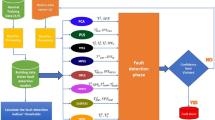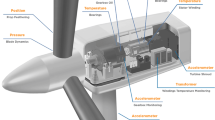Abstract
Diagnosis of complex engineered systems such as wind turbines poses a challenging task involving fault detection, localization, and repair activities. Wind turbines are equipped with a large number of sensors tracking their operation and condition. Data is continuously transmitted to a central monitoring system, where it can be used to automatically detect deviations between the observed and expected behavior. Based on the revealed anomalies, appropriate actions may be taken to restore an operational state. Whereas fault detection has been automated to some extent, localization is still performed mostly manually based on the experience of the service staff. This is inefficient due to limitations in available human resources, lack of long-term learning, and a high potential for false positives. In this chapter, we introduce an application that supports the process of efficient fault identification. Besides exploring the foundations, we present the overall diagnosis process as well as the software’s user interface, which has been developed in consideration of the typical work processes and environments of the maintenance staff. Further, we discuss the current stage of the application’s integration into the wind turbine diagnosis process.
Access this chapter
Tax calculation will be finalised at checkout
Purchases are for personal use only
Similar content being viewed by others
Notes
- 1.
Uptime Engineering GmbH provides consulting services as well as software tools in the field of technical reliability.
- 2.
A logical theory is acyclic in cases when it can be represented by a directed acyclic graph where each proposition is represented as a node and an edge is drawn from a proposition to another in case the former directly implies the latter.
- 3.
Here, efficiency is subjective to the application domain, e.g., in the context of wind turbines deriving explanations in minutes is sufficient, while for automotive on-board diagnosis this computation time is unacceptable.
- 4.
In the case of wind turbines, there is generally a strong single fault assumption. Thus, each depicted root cause in this example only consists of a single failure, e.g., IGBT module: Diode/IGBT wire bonding—TMF. Yet, the diagnosis engine is of course capable of determining multiple fault diagnoses.
- 5.
A notification for the person responsible for the entire installation is automatically generated containing the request. Only after the permission has been granted, may the technicians perform the maintenance work.
References
B. Abichou, D. Flórez, M. Sayed-Mouchaweh, H. Toubakh, B. François, N. Girard, Fault diagnosis methods for wind turbines health monitoring: a review, in European Conference of the Prognostics and Health Management Society (2014)
R. Bakker, P. Van den Bempt, N.J. Mars, D.J. Out, D. van Soest, Issues in practical model-based diagnosis. Futur. Gener. Comput. Syst. 9(4), 329–337 (1993)
C.S. Carlson, Understanding and applying the fundamentals of FMEAs, in Annual Reliability and Maintainability Symposium (2014)
L. Console, O. Dressler, Model-based diagnosis in the real world: lessons learned and challenges remaining, in Proceedings of the Sixteenth International Joint Conferences on Artificial Intelligence (1999), pp. 1393–1400
L. Console, D.T. Dupre, P. Torasso, On the relationship between abduction and deduction. J. Log. Comput. 1(5), 661–690 (1991)
M.O. Cordier, P. Dague, F. Lévy, J. Montmain, M. Staroswiecki, L. Travé-Massuyès, Conflicts versus analytical redundancy relations: a comparative analysis of the model based diagnosis approach from the artificial intelligence and automatic control perspectives. IEEE Trans. Syst. Man Cybern. B Cybern. 34(5), 2163–2177 (2004)
F.D. Davis, Perceived usefulness, perceived ease of use, and user acceptance of information technology. MIS Q. 13, 319–340 (1989)
J. de Kleer, An assumption-based TMS. Artif. Intell. 28(2), 127–162 (1986)
J. de Kleer, B.C. Williams, Diagnosing multiple faults. Artif. Intell. 32(1), 97–130 (1987)
E. Echavarria, T. Tomiyama, W. Huberts, G.J. van Bussel, Fault diagnosis system for an offshore wind turbine using qualitative physics, in Proceedings of EWEC (2008)
T. Eiter, G. Gottlob, The complexity of logic-based abduction. J. ACM 42(1), 3–42 (1995)
G. Fleischanderl, T. Havelka, H. Schreiner, M. Stumptner, F. Wotawa, DiKe-a model-based diagnosis kernel and its application, in KI 2001: Advances in Artificial Intelligence (Springer, Berlin, 2001)
G. Friedrich,G. Gottlob, W. Nejdl, Hypothesis classification, abductive diagnosis and therapy, in Expert Systems in Engineering Principles and Applications (Springer, Berlin, 1990), pp. 69–78
C.S. Gray, S.J. Watson, Physics of failure approach to wind turbine condition based maintenance. Wind Energy 13(5), 395–405 (2010)
C. Gray, F. Langmayr, N. Haselgruber, S.J. Watson, A practical approach to the use of SCADA data for optimized wind turbine condition based maintenance, EWEA Offshore Wind Amsterdam (2011)
Z. Hameed, Y. Hong, Y. Cho, S. Ahn, C. Song, Condition monitoring and fault detection of wind turbines and related algorithms: a review. Renew. Sust. Energ. Rev. 13(1), 1–39 (2009)
R. Koitz, F. Wotawa, Finding explanations: an empirical evaluation of abductive diagnosis algorithms, in Proceedings of the International Conference on Defeasible and Ampliative Reasoning, CEUR-WS.org (2015), pp. 36–42
R. Koitz, F. Wotawa, From theory to practice: model-based diagnosis in industrial applications (2015), in Proceedings of the Annual Conference of the Prognostics and Health Management Society (2015)
R. Koitz, F. Wotawa, On the feasibility of abductive diagnosis for practical applications, in Proceedings of the 9th IFAC symposium on fault detection, supervision and safety of technical processes (2015)
R. Koitz, F. Wotawa, Integration of failure assessments into the diagnostic process, in Proceedings of the Annual Conference of the Prognostics and Health Management Society (2016)
R. Koitz, J. Lüftenegger, F. Wotawa, Model-based diagnosis in practice: interaction design of an integrated diagnosis application for industrial wind turbines, in Proceedings of the 30th International Conference on Industrial Engineering and Other Applications of Applied Intelligent Systems (2017)
H.J. Levesque, A knowledge-level account of abduction, in Proceedings of the Eleventh International Joint Conferences on Artificial Intelligence (1989), pp. 1061–1067
B. Lu, Y. Li, X. Wu, Z. Yang, A review of recent advances in wind turbine condition monitoring and fault diagnosis, in Power Electronics and Machines in Wind Applications, 2009. PEMWA 2009. IEEE (IEEE, Piscataway, 2009), pp. 1–7
H. Milde, T. Guckenbiehl, A. Malik, B. Neumann, P. Struss, Integrating model-based diagnosis techniques into current work processes–three case studies from the INDIA project. AI Commun. 13(2), 99–123 (2000)
J. Nielsen, Iterative user-interface design. Computer 26(11), 32–41 (1993)
D. Poole, R. Goebel, R. Aleliunas, Theorist: a logical reasoning system for defaults and diagnosis, in The Knowledge Frontier (Springer, New York, 1987), pp. 331–352
L. Rademakers, A. Seebregts, B. van Den Horn, Reliability analysis in wind engineering. Netherlands Energy Research Foundation ECN (1993)
R. Reiter, A theory of diagnosis from first principles. Artif. Intell. 32(1), 57–95 (1987)
M. Schlechtingen, I.F. Santos, S. Achiche, Wind turbine condition monitoring based on scada data using normal behavior models. Part 1: system description. Appl. Soft Comput. 13(1), 259–270 (2013)
L. Simon, A. Del Val, Efficient consequence finding, in Proceedings of the Seventeenth International Joint Conference on Artificial intelligence (2001), pp. 359–365
P. Struss, Model-based problem solving, in Handbook of Knowledge Representation, Chap. 10, ed. by F. van Harmelen, V. Lifschitz, B. Porter (Elsevier Science, Oxford, 2008), pp. 395–465
P. Struss, A. Malik, M. Sachenbacher, Case studies in model-based diagnosis and fault analysis of car-subsystems, in Proceedings of the 1st International Workshop Model-Based Systems and Qualitative Reasoning (1996), pp. 17–25
P. Struss, M. Sachenbacher, C. Carlén, Insights from building a prototype for model-based on-board diagnosis of automotive systems, in Proceedings of the International Workshop on Principles of Diagnosis (2000)
Y. Sun, D.S. Weld, A framework for model-based repair, in Proceedings of the Eleventh National Conference on Artificial Intelligence (1993), pp. 182–187
N. Tazi, E. Châtelet, Y. Bouzidi, Using a hybrid cost-FMEA analysis for wind turbine reliability analysis. Energies 10(3), 276 (2017)
M. Wilkinson, B. Hendriks, F. Spinato, K. Harman, E. Gomez, H. Bulacio, J. Roca, P. Tavner, Y. Feng, H. Long, Methodology and results of the reliawind reliability field study, in European Wind Energy Conference and Exhibition 2010, EWEC 2010, Sheffield, vol. 3 (2010), pp. 1984–2004
F. Wotawa, On the use of abduction as an alternative to decision trees in environmental decision support systems, in International Conference on Complex, Intelligent and Software Intensive Systems, 2009. CISIS’09. (IEEE, Piscataway, 2009), pp. 1160–1165
F. Wotawa, Failure mode and effect analysis for abductive diagnosis, in Proceedings of the International Workshop on Defeasible and Ampliative Reasoning (2014), pp. 1–13
F. Wotawa, I. Rodriguez-Roda, J. Comas, Environmental decision support systems based on models and model-based reasoning. Environ. Eng. Manag. J. 9(2), 189–195 (2010)
W. Yang, J. Jiang, Wind turbine condition monitoring and reliability analysis by SCADA information, in Second International Conference on Mechanic Automation and Control Engineering (MACE), 2011. (IEEE, Piscataway, 2011), pp. 1872–1875
A.S. Zaher, S. McArthur, A multi-agent fault detection system for wind turbine defect recognition and diagnosis, in 2007 IEEE Lausanne Power Tech (2007), pp. 22–27
Acknowledgements
The work presented in this paper has been supported by the FFG project Applied Model Based Reasoning (AMOR) under grant 842407 and the SFG project EXPERT. We would further like to express our gratitude to VERBUND Hydro Power GmbH.
Author information
Authors and Affiliations
Corresponding author
Editor information
Editors and Affiliations
Rights and permissions
Copyright information
© 2018 Springer International Publishing AG
About this chapter
Cite this chapter
Koitz, R., Wotawa, F., Lüftenegger, J., Gray, C.S., Langmayr, F. (2018). Wind Turbine Fault Localization: A Practical Application of Model-Based Diagnosis. In: Sayed-Mouchaweh, M. (eds) Diagnosability, Security and Safety of Hybrid Dynamic and Cyber-Physical Systems. Springer, Cham. https://doi.org/10.1007/978-3-319-74962-4_2
Download citation
DOI: https://doi.org/10.1007/978-3-319-74962-4_2
Published:
Publisher Name: Springer, Cham
Print ISBN: 978-3-319-74961-7
Online ISBN: 978-3-319-74962-4
eBook Packages: EngineeringEngineering (R0)




